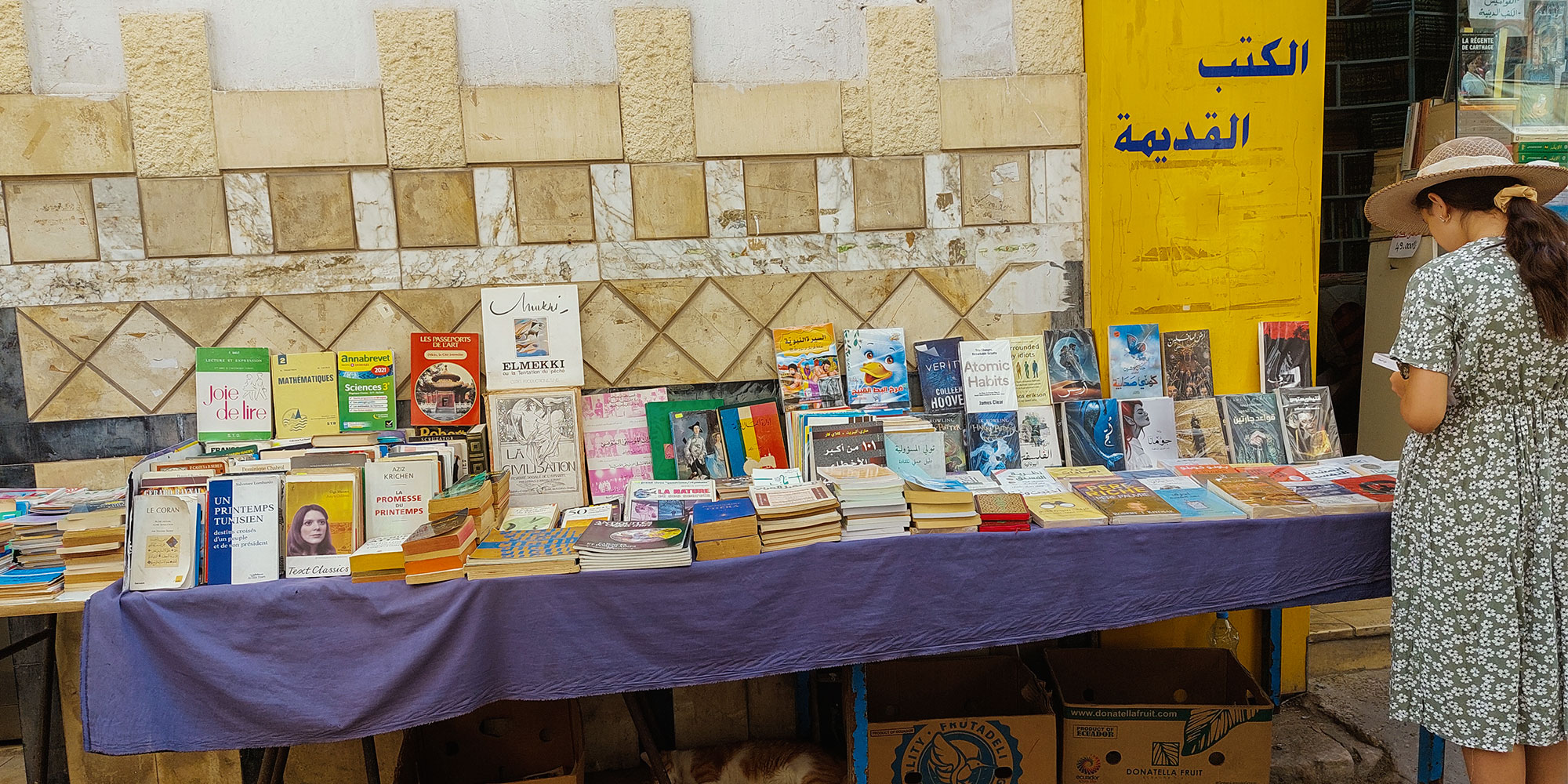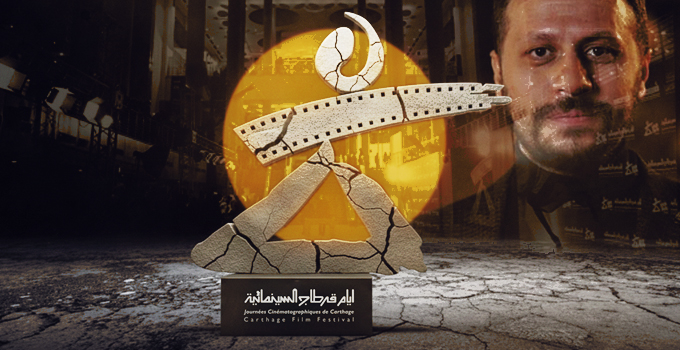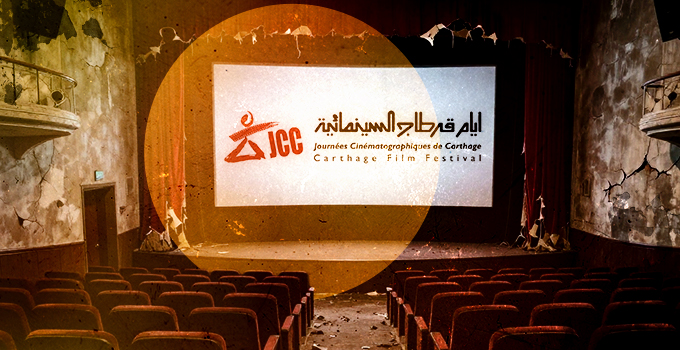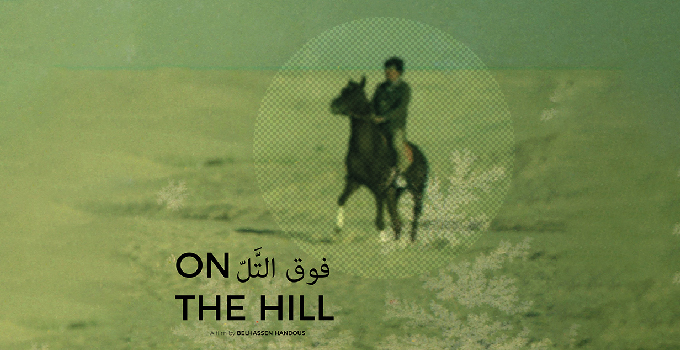With crossed arms, head down and a distant gaze, the vendor appears wholly unconcerned that anyone might steal his merchandise—second-hand books displayed atop a stand on Dabaghine street. In Arabic, the name refers to the leather tanners who once occupied the street before being pushed out for the pollution caused by their work.
Only one customer is here, a young girl who flips through the pages of a book before setting it down. “I’ve been doing this work for 37 years, seen thousands of people pass by. Over time, they’ve been reduced to hundreds, then dozens,” the vendor remarks bitterly.
For decades, used book merchants have set up shop on Dabaghine street. They have watched the times change along with the face of customers. “People hardly bother to stop anymore, to open up a book,” the man observes despairingly.
In this souk, an air of nostalgia mingles with the scent of old paper. The ravages of time are visible on the faces of the booksellers, most of them elderly, as well as on the books themselves. The few who still keep their shops open are in an ongoing slump that has yet to be named.
Just another piece of merchandise
It is the morning of September 5, and there is hardly any foot traffic around book stands which crowd the street and adjoining alleys. And yet some of the books here are a steal: children’s books for just 500 millimes, classics of Arabic and French literature for only three dinars.
Historical works share shelf space with philosophical works by Marx, novels such as “The Red and the Black” by Stendhal, the adventures of Harry Potter, scientific tomes, educational materials and books on living well.

Rare are the customers who take time to dig through this catch-all of reading material. Most take a quick glance before continuing on their way. The few who do show interest must practice patience as they go through boxes filled with stacks of books. Plastic palettes form the legs of stands where boxes are set out; others are simply placed on the ground, as are some vendors’ books.
With the start of the school year, many parents come looking for textbooks and educational materials. “They are pretty expensive in bookstores,” says one young mother, a regular of this souk. Two Algerian customers are on the hunt for the front pages of old newspapers. The cost of one alone is 50 dinars.
Shelves display old books upon whose yellowed pages one finds passages underlined in pencil or comments scribbled into the margins. Interspersed between these classic tomes are newer publications. The piles of books are like walls.
Lost in his bazaar, one vendor is unable to locate a novel requested by a customer. He is similarly lost when asked to estimate the market value of certain books.
The novel “Happening” by author Annie Ernaux, recipient of the 2022 Nobel Prize in literature, is sold for 30 dinars in bookstores. This vendor is selling it for six dinars, although it is like new.

70-something Mahmoud who lives in France is thrilled by his catch of the day: encyclopedias and novels for his children. “In France, you sometimes find them for over a hundred euros. Here, I buy them for ten euros, and the vendor is happy,” he tells us. Mahmoud notes that “Some vendors underestimate the value of their books.”
The souk’s vendors, however, insist that the opposite is true, and that they themselves are lovers of literature. Others admit that they simply wound up in the profession. “I could have been a produce vendor, but destiny had it that I was to sell used books,” one of them tells us. He has been doing so for about 30 years. For this merchant, a book is like a kilo of vegetables. “Tunisians struggle to buy a kilo of potatoes. The same is true for a book,” he explains didactically. Talking to this vendor, one gets the impression that books are a type of merchandise like any other.
Some vendors are willing to reduce an initial price of ten dinars to the end of enticing reluctant customers.
The same logic applies in price negotiations with book owners, who sell their books by the box. The going rate for these boxes varies widely, “ranging from 40 to 300 dinars,” explains one intermediary between owners and used book vendors. He makes a living doing this, a job which he says requires having connections. The intermediary purchases books from private owners and bookstores. In this circuit, “there is something for everyone,” he says with a tone of satisfaction. Covered in perspiration, he has just delivered a box and large grocery store tote full of books to a vendor. He relates that he has been doing this work for over 20 years, and that he also knows the value of what he sells.

Oftentimes he doesn’t have to try hard to get the price he wants. Some owners, especially in La Marsa (northern suburb of the capital), are eager to “get rid of” these books which generally once belonged to a deceased relative.
Some of the children of those who have died are, for example, scientists unlike their mother or father. For them, these books are like an old impractical piece of furniture that they have to take apart in order to gain space.
Such bargains are apparently not enough to please vendors. The confinement imposed during the Covid pandemic impacted the sector, say booksellers, who further complain of having to haggle with potential clients to reduce prices that are already low to begin with. “All they have to do is go to the bookstores to see what some books are worth. You can’t even compare their prices to ours.”
Brand new, the first volume of the book “The Second Sex,” by Simone de Beauvoir costs nearly 50 dinars. In this souk, both volumes—in good condition—can be found for half the price, about 25 dinars.
A dozen or so second-hand book stores closed up shop after the passing of their owner. Deemed unprofitable, these businesses never found new owners to take them over, one vendor remarks with an air of resignation.
“The sewing and fabric shops do much better. That’s why they occupy stores on the main street where rent is higher,” he explains. Aside from a few stalls the main drag, most used booksellers are concentrated in the adjacent side streets. The crowds are mostly to be found in fabric and sewing shops.
Close to noon, vendors start to lay out pieces of cardboard over books displayed on the ground to protect them from the sun. There is hardly a customer in sight, except for those who have flocked to a neighboring stand selling fricassé. Here, there is a ten-minute wait to place an order.
Tunisians and reading: a romance-less story
Over time, the profile of customers has changed, these booksellers report. Today, many of them are students looking for books related to their specialty, or parents attracted by bargains on educational books. Few are truly passionate about literature. 27-year-old Montassar who studies English language and literature is an exception. A regular at Dabaghine, Montassar comes every week to rummage through this trove of books, often in search of English literature novels, he tells us.
“Here you can stumble upon rare editions of books that are no longer in print, or that you have to order from bookstores for exorbitant prices,” he affirms.
Clients like Montassar stand out from the majority of Tunisians. For nearly 70% of the population, the only reading material at home is the Quran or old newspapers. 86% did not buy a book in 2021. This lack of interest in reading is also manifest in the attendance at public libraries.

The number of patrons in public libraries for adults, youth and children fell by more than 50% in five years, from 3.1 million in 2016 to 1.4 million in 2020. Between 2019 and 2020, this number dropped by one million. In 2019, there were 171,125 library card holders across the country’s 434 public libraries. In 2020, there were 127,293. The number of books checked out dropped from 2.6 million in 2016 to 1.7 million in 2020.
According to one bookseller at Dabaghine, Tunisians do not read because of the internet. People are absorbed by their telephones, and social media in particular. And those who still show interest in reading prefer screens to paper.
Young and old alike have access to a vast selection online. Electronic books can be downloaded for free. This is how 15-year old Ines usually spends her time reading. Today, she and her mother are looking for the girl’s favorite novels. Ines loves fantasy books in Arabic. “This is my first time here. Usually I download books from the internet,” she explains.

Nearby, a father and his little boy are leafing through a manga. Two young women in their early twenties seem to have found what they are looking for: pieces by Russian novelist Fyodor Dostoyevsky, translated into Arabic.
“Arabic is more accessible for me than English or French,” says one of the young women. An old bookseller, passionate about both French and Arabic literature, is delighted. “Unlike customers who come looking for life coach books or sappy novels,” he says happily, adding, “All of our human relations are in ruin because we don’t read like before. Empty heads are not apt to understand the world, nor how to behave.” As he talks, not a single customer remains in sight.

Others are more optimistic, pointing out the popularity of Tunisian writers like Amira Ghenim and Hassanine Ben Amou. “Books by Faten Fazaa sell like hot cakes,” says one vendor.
And yet there is no guarantee that such successes are any match for the crisis which is stifling the booksellers at Dabaghine, as well as the country’s libraries and publishing houses. All of whom are unlikely to be the first to breathe new life into the sector. “We are neglected by the public authorities. Not a single official from the Ministry of Cultural Affairs has ever come to see us,” remarks one bookseller.





iThere are no comments
Add yours